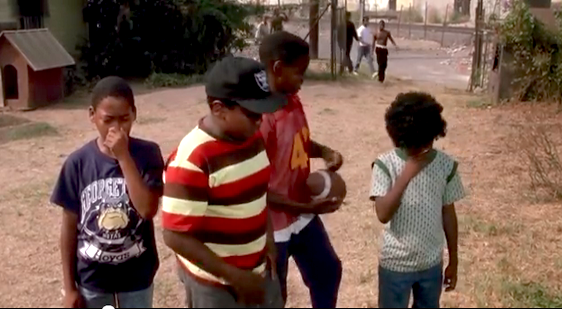Lynn Lee revisits the John Singleton classic on its 25th anniversary.

Four young boys walk along a railroad track, idly chatting but in search of something specific. They find what they’re looking for: a dead body. A group of older boys arrives and harasses them. The most pugnacious of the younger group fights back in a way that foreshadows his destiny as an adult.
Stand by Me? No, Boyz n the Hood, which opened in theaters 25 years ago today. And the parallels are no mere coincidence. Writer and drector John Singleton was intentionally referencing the earlier Rob Reiner film – perhaps as much for the differences as the similarities between the two narratives of boyhood and the cultural spaces they occupy...
Yet that scene also encapsulates why Boyz n the Hood drew such a powerful response when it first premiered and why it still resonates across racial lines today. Even though it’s about the very specific experience of growing up black and male in south central L.A., it also struck a more broadly familiar chord as a narrative of growing up, period. True, the fears and threats that beset Tre Styles were darker than what many moviegoers had ever known, but they were framed by a perspective anyone could embrace: the bright, thoughtful, basically centered kid who still feels the pull of wayward impulses and conflicting influences. Who couldn’t empathize with that kid and, by extension, with his yearning to escape the endless cycle of death and vengeance?

That capacity for empathy struck me especially sharply as something we could all use a good deal more of these days. The film feels surprisingly fresh even today, late ’80s synth-heavy soundtrack and hip-hop fashions notwithstanding. What also surprised me is how quiet it is, quieter than I remembered. Although it opens memorably with darkness, gunshots, and a sobering statistic (“One out of every 21 black American males will be murdered in their lifetime”) and ends with brutal execution-style killings, it’s no Menace II Society or any of the other similarly themed movies that followed in its wake. Gang culture is all around Tre (played as an adult by Cuba Gooding, Jr.), but more often in the background, like the air he breathes, except when it’s punctured by flickers of dread – a car passing and slowing down, a window rolling down – or bursts of senseless violence. While that makes the climactic killing scenes all the more wrenching, the most effective moments are still the quiet ones: The awkward visit of a college football recruiter to the home of Tre’s friend Ricky (Morris Chestnut). The final scene between Tre and Ricky’s brother (Ice Cube, excellent). The few scenes between Tre’s parents (Laurence Fishburne and Angela Bassett), divorced but deeply invested in their son’s welfare. Every one-on-one scene between Tre and his father, underscoring one of the movie’s overarching themes - the supreme importance of having a good father.
Therein lies the chief conundrum of the film, for me – what to make of its treatment of women?
For the most part the movie portrays the female characters, the mothers and girlfriends, sympathetically, and has little use for the casual misogyny of gangsta culture. Yet the women in the movie tend to stay on the sidelines of the story. While Bassett makes the most of her limited appearances as Tre’s mother Reva, the long and short of her role is to turn the parenting over to his father once he starts acting out. It’s implied there are other considerations at work, too, such as Reva’s desire to pursue her own education and career, which she appears to do successfully. Still, it’s hard not to read her decision as ultimately vindicated both by Tre’s eventual success and by the contrasting example of Doughboy and Ricky, whose single mother (Tyra Ferrell) does the best she can but seems to have no idea how to deal with the more difficult of her two sons—and ends up losing them both. The moral is a little too clear: boys in dangerous circumstances need the firm and steady guiding hand of a father, without which they’re doomed to succumb to the worst of their environment. Or, as Reva tells her ex-husband

I can’t teach him to be a man. That’s your job.”
And teach he does; no one pontificates quite as well as Fishburne, who vests his character with gravitas without, somehow, becoming too insufferable.
Paternalism and didacticism aside, there’s no denying the major cultural impact of Boyz n the Hood, both in its influence on African American filmmaking and its demonstration that movies by black directors who weren’t Spike Lee and starring all-black casts could be mainstream hits. It was Oscar-nominated for best director and best screenplay, losing to Silence of the Lambs and Thelma and Louise, respectively. While Singleton, who was only 23 at the time he made the movie(!), hasn’t quite captured the zeitgeist in the same way since then, he’s enjoyed a solid career – as has most of the cast, albeit some in more checkered fashion than others. (CBGJ, looking at you.) Still, one can’t help look back at the success of Boyz n the Hood and wonder if there will ever be anything quite like it again: a movie about black experience, made by black people, that was embraced by such a wide swath of non-black moviegoers. I sincerely hope so. We need a movie like that, for these times, more than ever.